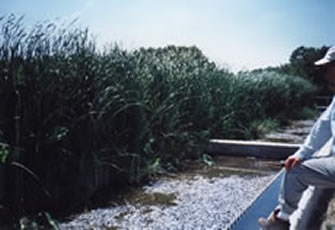CONSTRUCTED WETLANDS FOR STORM AND WASTE WATER TREATMENT
Byline : John W. Salm, III, P.E.
Part 3
 The
Reaeration Bed aerates the water from the Denitrification Bed and allows its
chemical characteristics to readjust to an oxidizing environment. In addition,
natural disinfection is provided as the water trickles through the aerobic
sand. The Reaeration Bed is particularly effective for final polishing of
residual contaminants and for preparing the water for discharge.
The
Reaeration Bed aerates the water from the Denitrification Bed and allows its
chemical characteristics to readjust to an oxidizing environment. In addition,
natural disinfection is provided as the water trickles through the aerobic
sand. The Reaeration Bed is particularly effective for final polishing of
residual contaminants and for preparing the water for discharge.
Each bed performs a different treatment function in addition
to preparing the water for the following process and backing up the previous
process. The final effluent quality from the constructed wetland tertiary
treatment system is very stable and has essentially been converted back to clean
water prior to leaving the treatment system. This effluent is highly suitable
for intensive recharge and also for beneficial reuse, if the conditions warrant.
Organics, Nitrogen and Phosphorus are the primary contaminants
from which impacts surface and ground waters. Nitrogen is often times the
toughest parameter to treat for, therefore, the HIRP constructed
wetlands is designed to optimize Nitrogen removal. As a result of the intensive
treatment for Nitrogen removal, other contaminants (i.e. BOD, TSS, Phosphorous,
Metals, Trace Organics) are also removed to exceptionally low values. Typical
performance for one HIRP system is shown below.
Back to Lectures page
 The
Reaeration Bed aerates the water from the Denitrification Bed and allows its
chemical characteristics to readjust to an oxidizing environment. In addition,
natural disinfection is provided as the water trickles through the aerobic
sand. The Reaeration Bed is particularly effective for final polishing of
residual contaminants and for preparing the water for discharge.
The
Reaeration Bed aerates the water from the Denitrification Bed and allows its
chemical characteristics to readjust to an oxidizing environment. In addition,
natural disinfection is provided as the water trickles through the aerobic
sand. The Reaeration Bed is particularly effective for final polishing of
residual contaminants and for preparing the water for discharge.